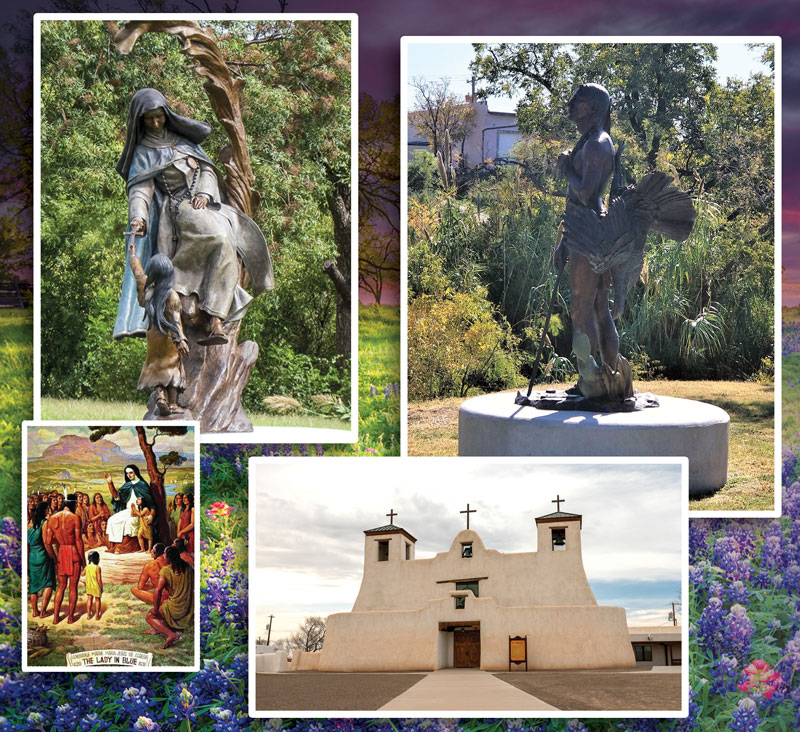
While legends often sound far-fetched, all of them have a basis of truth. In the case of María de Jesús de Ágreda, many pieces of her story have no explanation outside a mysterious and miraculous event.
Born April 2, 1602, María Fernández Coronel grew up with a zeal for telling people the Gospel story, wanting nothing more than to see people come to a saving knowledge of her Lord. From early childhood, she longed to become a missionary in the New World. Unfortunately, young girls of her era didn’t have that career option.
Some say even as an infant, she had divine knowledge. A child prone to visions, preoccupation with spirituality and obsessed with compassion for the poor, her family misunderstood her. Often feeling wounded and unloved, she retreated to the depths of her soul. With desires of mission work squashed, María made a decision. At only 8 years old, the girl announced a determination to take a chastity vow and enter the sisterhood.
Seven years later, her father and two brothers entered a monastery. Following what they all believed as guidance from the Lord, María’s parents converted their castle into a convent — the Franciscan Convent of the Immaculate Conception at Ágreda. Sister María de Jesús (as she was known after taking her vows) entered the sisterhood without ever leaving her home.
Instead of esteeming her, the other nuns ridiculed and humiliated her. At one point, the Mother Superior requested an ecclesiastical examination. After much questioning, the Provincial of Burgos, Fray Anthorn de Villacre, declared her neither foolish nor mad. He declared that Sister María de Jesús attained true sanctity, a transcendent state of spirituality. The nuns then held her in the highest esteem, thrusting her into unwanted limelight.
Not long after that, during fervent prayer following communion one day, the young nun entered a trance. She found herself walking among dark-skinned men where they gathered, hunted and lived a simple life. Returning many times in the same fashion, sometimes two and three times a day, she taught them the fundamentals of Christian faith and lifestyle. Sister María de Jesús claimed over 500 visits to the New World, although she physically never left Spain.

Later, under the guidance of her confessor, Francisco Andres de la Torre, she detailed accounts of her journeys in a book titled, The Mystical City of God. Questioned extensively, Sister María de Jesús provided glorious details that she could not possibly know without having been among the native Americans.
The Jumano tribe, inhabitants of Texas and parts of New Mexico, have long shared stories of the Blue Nun. They say she appeared hundreds of times to them, coming from the sky. Because of the cobalt blue clothing she wore, they called her the Lady in Blue. Many settlers also claimed this same woman came to them, ministering to their souls.
The Jumano Braves, moved by the nun, traveled to a mission in New Mexico and shared with the priests what they learned from her. From 1620, increasing numbers of native Americans came, requesting missionaries so they could learn more and receive blessings. When friars finally visited the village, the natives welcomed them with two wooden crosses, covered with flowers they said the Lady in Blue helped them decorate. When shown a photo of an older Franciscan nun, they declared their Lady in Blue wore the same clothing but was much younger and very beautiful.
The Jumano legend states that the morning after the Blue Nun’s last visit, they woke to a field of beautiful flowers that matched the color of her cloak. According to them, the Texas bluebonnet appeared in her absence.
A few years after her death in 1665, the church declared Sister María de Jesús de Ágreda venerable. In the 20th century, they opened her coffin and found the beloved nun’s body uncorrupted by death.
Did she indeed visit America at the same time she remained in Spain? Some believe she did, although no one can explain the possibility of such visits outside a miracle of bi-location.
Those who saw the Lady in Blue recorded and told their stories for generations. Whether a true visit by a miracle, or a vision that appeared to many people, the Jumano tribe, settlers and others learned about Christianity — enough to want more knowledge and blessings from the church. Sister María’s deepest desire to see people in the New World learn about Christianity came to fruition — a fact history can’t dispute.
Sources:
1. www.mariadeagreda.org/en/who-was-she/the-lady-in-blue/.
2. www.studylight.org/encyclopedias/eng/bri/m/maria-fernandez-coronel-abbess-of-agreda.html.
3. www.desertusa.com/desert-people/lady-in-blue.html.
4. www.texashillcountry.com/texas-bluebonnet-legends-myths/.
Written by Lisa Bell

You must be logged in to post a comment.